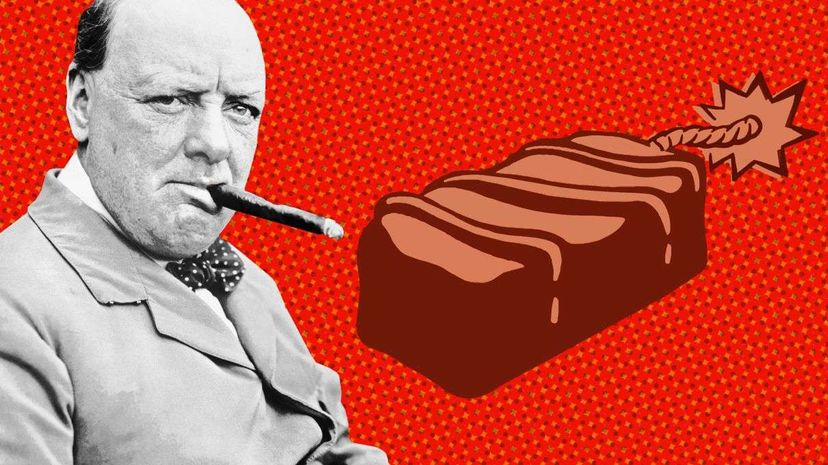
British Prime Minister Winston Churchill was one of Europe's first leaders to vocally oppose Adolf Hitler and the Nazi regime. Churchill's radio broadcasts bolstered the faith of a frightened people, and Hitler desperately wanted him dead. But how would the Nazis reach such a preciously protected human resource? The big idea was sweet subterfuge.
In 2012, letters stamped "secret" revealed a curious project commissioned by Lord Victor Rothschild, an M15 senior intelligence chief. Rothschild wrote to illustrator Laurence Fish to request diagrams of exploding chocolate bars and other cleverly disguised explosive devices. A letter dated May 4, 1943, described a possible Nazi plot to kill Churchill by smuggling a sinister, sweet treat into the War Cabinet's dining room. The treat in question was a chocolate bar finely wrapped in black and gold paper and labeled "Peters Chocolate." The good wouldn't have aroused suspicion because it was actually chocolate.
Advertisement
According to a British spy who saw the chocolate bar explosive and drew the first rendering of the device, it was a steel plate covered by a thin layer of dark chocolate. When the chocolate bar was broken at its lines of demarcation, only then would the canvas strap connected to the explosive inside be revealed. The device was rigged to explode after a seven-second delay following the snap; its effects would be felt within several feet (or meters) of the explosion.
In Rothschild's instructions to Fish, he asked the illustrator to include notations on the chocolate bar diagram about the seven-second delay. He also included the spy's original rendering, convinced that Fish would improve upon it. Rothschild intended for Fish's collected illustrations to be distributed in an effort to promote knowledge of how to defuse explosives. In total, Fish made 25 drawings.
The BBC cites historian Nigel West, who asserts that Rothschild probably paid out of pocket for the diagrams. This isn't surprising given Rothschild's wealth and largesse toward the empire; after all, this is the man who offered up one of his mansions as MI5 offices in Paris. When the illustrations were complete, Rothschild was pleased enough with the results to have one framed for his home library and to put the remaining prints safely in storage.
When the aforementioned correspondence was discovered back in 2012, historians wondered: Where are the illustrations? In early September 2015, members of the Rothschild family were sorting through documents when they discovered them. Historical importance aside, experts considered them remarkable for pre-digital graphics.
The chocolate bar illustration proved particularly compelling. And it wasn't entirely beyond the realm of possibility that it could work. After all, as Vice reports on the issue, people have to eat! The act of breaking a chocolate bar to detonate an explosive device requires minimal effort from the consumer, yet it yields a devastating impact. Since the device was designed to look like a normal chocolate bar, it therefore would have possessed the properties of chocolate.
It's significant that the Germans used dark chocolate for the explosive. Dark chocolate was better suited for the task than milk chocolate — and that has everything to do with how it's tempered.
To temper chocolate means to melt it, then stir it vigorously as it cools. Pastry chef David Lebovitz explains that tempering is essential to ensure the formation of beta crystals in the chemical composition of the chocolate. Beta crystals alter the structure of chocolate to prevent it from forming streaky white marks or blotches on the surface.
These crystals also ensure that chocolate won't melt when you hold it (the human hand is a lot warmer than a candy bar wrapper) and that when it's reshaped — say, when a chocolatier presses it into a heart-shaped mold — it will slip out easily from its container and retain that shape. What's more, tempering creates what Lebovitz describes as a "glossy, shiny appearance and a crisp, clean snap when you break it."
A chocolatier will only temper chocolate that's being served as candy or pastry décor; there's no need to exert the effort for chocolate that's being used as an ingredient and folded into recipes. Once chocolate is tempered, the chocolatier can add any number of ingredients to it: nuts, fruit and even dairy products to convert it from dark to milk chocolate. The more cocoa in the finished product, the sharper and cleaner the snap. If the chocolate gives softly when it's broken, it's milk chocolate. If it resists the motion and makes that audible snap, it's dark chocolate.
This takes us back to the Nazis' chocolate plot. Not only would the dark chocolate have been glossier and more luxurious-looking, the sharp snap likely would have been more conducive to triggering the device beneath it.
Luckily for Churchill, that theory wasn't tested. Ultimately, the chocolate's lasting legacy was a curious illustration devoted to detonation education.
Do you love history as much as we do? Then be sure to check back in to HowStuffWorks Now every week. We'll be publishing a new (old) ridiculous history article every Monday.
Advertisement